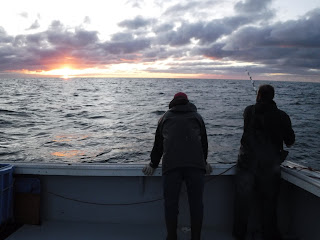We arrived in Port Hood on the 19th September to kick-off the 2017 giant bluefin tagging season in the Gulf of St Lawrence, Canada. This year we are pop-up tagging to study movements and habitat use over periods of up to a year, as well as acoustic tagging. Acoustic tags have a life span of up to 10 years and emit an acoustic signal every minute or so. These signals can be “heard” by any listening stations that are in range (within half a kilometre or so) and can provide unrivalled data documenting repeat fidelity of Atlantic bluefin tuna to areas where acoustic receivers are present, such as the Gulf of St Lawrence. As these tags stay active on the fish for such long periods, we can estimate natural mortality rates for the species, which have been previously very tough to estimate. Once incorporated into fisheries models, by combining with ‘F’ (fishing mortality), our hope is that this will further bolster efforts to accurately define annual population losses to help inform management.
Although the tags are slightly different, our goal on the water is the same; catch and release bluefin tuna. Robbie Schallert and Tom Horton met with Dennis Cameron and Lloyd MacInnes on the morning of the 20th to get the Canada 2017 field season going, this was after hearing that the previous day there were 30 hook-ups in the fleet before 7am. The herring had already begun spawning near Port Hood.
 |
| A charter boat gets hooked up as some of the rest of the fleet look on. |
 |
| Dennis Cameron looking on as one of the herring boats hauls a net laden with fish just after dawn. |
 |
| Craig Cameron has been a part of our tagging team in the past; this year he's knee deep in herring on his own boat |
This means that bluefin arrive in the early hours to pick off herring that escape as the fleet haul their nets. It usually means good bluefin fishing, and our first day was no exception. We had our first bite at 9:30am and by the close of play we had lost one and released three with acoustic and pop-up tags. This included a 299cm fish, the third largest we have ever tagged. It’s always a real privilege to see a fish that has run the fisheries gauntlet and won for nearly two decades, and we were very happy to see it go back out the transom door with an acoustic tag.
 |
| Robbie, Tom, Dennis and Lloyd haul a 299cm bluefin aboard for electronic tagging. |
After day three we are 9 fish tagged for 10 hooked up. So, a good start but plenty more work to do. We’ve certainly been blessed with some very un-Nova Scotia – like weather and were even on the boat in shorts yesterday. We’re sure that will change……
|
|
A rare glint of sun off a bluefin tuna prior to tagging in the Gulf of St. Lawrence.
|












